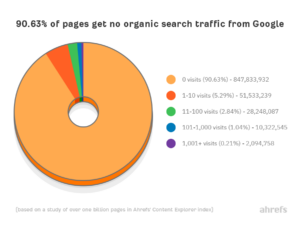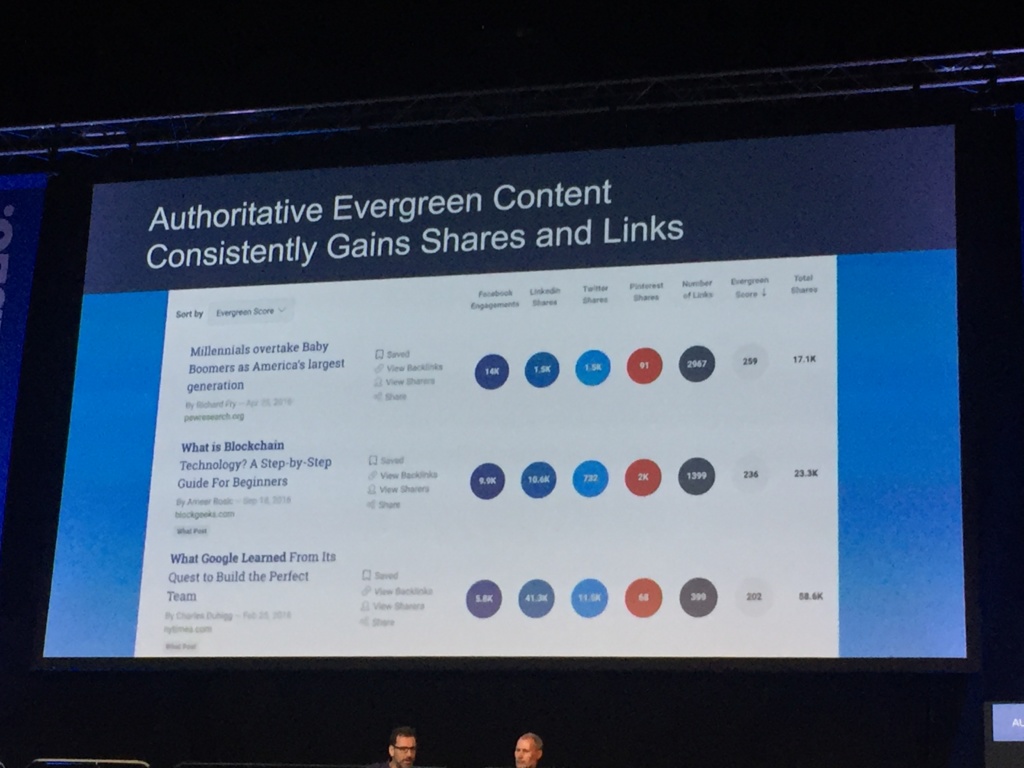
Writing high-quality content that ranks can be time-consuming, sure, but it’s one of the most powerful ways to create meaningful engagement and drive qualified traffic to your site. That’s why it’s even more frustrating when you don’t see floods of comments, legions of visitors, and a surge in rankings — even after a few months.
The answer? Reoptimising underperforming content.
Let’s throw it all the way back to BrightonSEO 2018, when content pruning was discussed as a way of navigating the Google Panda update, which intended to prevent sites with poor quality content from ranking. This practice is still as relevant today as it was then.
Just as a gardener carefully trims away overgrown or dead branches to encourage healthy growth, content marketers must similarly prune their digital content, revisiting older posts, cutting out outdated points or dead links, and enriching the content with up-to-date information and keywords.
So, how can you protect your content from Google penalties and prevent underperformance? Here’s Seeker’s guide to breathing new life into underperforming blogs.
How to know when content is underperforming
When we talk about “underperforming content”, we’re referring to pages that fail to live up to their potential. This can show in various ways, such as content that once attracted substantial organic traffic but has now lost its momentum, or content that never gained organic traction despite your best efforts.
Shockingly, more than 90% of content receives zero traffic from Google! So, a staggering nine out of every ten pages are likely to remain completely unnoticed, meaning they’re effectively unable to generate engagement, visibility, or leads — how very sad!

But why is so much online content failing to generate organic search traffic? Here are a few reasons your content may be underperforming:
- Declining organic traffic. A noticeable drop in the organic traffic your content once enjoyed is a clear sign of underperformance.
- Low engagement metrics. Analyse metrics such as time spent on the page, bounce rate, and social shares. If these are consistently low, your content may not be resonating with your audience.
- Poor keyword rankings. If your content is not ranking well for relevant keywords, it might be missing the mark in terms of search engine optimisation.
- Limited backlinks. The absence of backlinks or a minimal number suggests that others in your industry may not find your content valuable or authoritative.
- Outdated information. In rapidly evolving industries, outdated content can lose its relevance quickly, leading to a decline in its performance.
- Incompatibility with algorithms. Changes in search engine algorithms may impact content visibility. Regularly assess and adapt your content to align with evolving algorithms.
It’s also important to remember that if some of your content does seem to be underperforming, this doesn’t necessarily reflect the overall quality of your entire content strategy. Sometimes, particular pieces of content just don’t work as well as you hoped. Finding and updating old content is an important part of a successful content maintenance strategy.
What are the causes of underperforming content?
There are several factors that may contribute to content underperformance, such as it being outdated, irrelevant, or simply not comprehensive enough. Ultimately, these all lead back to the point that the content in question simply isn’t good enough and does not deserve to rank in the top organic positions compared to your competition.
Reasons your content may be underperforming include:
- Poor SEO practices. Neglecting SEO practices like using relevant keywords, meta descriptions, and proper tagging can make it less likely that Google will rank your content.
- Low-quality content. Ultimately, content that is ‘thin’, poorly written, uninformative, or unengaging can turn readers away. High-quality content, on the other hand, is informative, well-researched, and engaging.
- Failure to understand your target audience. If your content is not tailored to the interests, needs, and preferences of your target audience, it may fail to resonate with them, leading to low engagement.
- Outdated or irrelevant content. Content that is not timely or relevant may fail to attract traffic, while it can quickly become outdated due to shifting trends and user behaviours.
- Lack of promotion. Even great content needs promotion. Not utilising social media, email newsletters, or other channels to promote content can lead to it going largely unnoticed.
- Not posting frequently enough. Regularly publishing content helps generate interest and keep users coming back, whereas infrequent or inconsistent posting can lead to a loss of regular visitors.
- Lack of visuals and multimedia. Content that lacks appealing visuals can be less engaging compared to content that effectively uses images, videos, or infographics.
- Not tracking performance. Failing to use analytics tools to track the performance of your content means you’ll be unable to identify and address underperforming content in the first place.
Sometimes, it can be difficult to discern why your content is failing to perform, particularly if you feel like you’re following all the best practices. However, if you look at the top search results for your target keywords and see how your content compares, it will probably become a lot clearer as to why your piece doesn’t quite meet the mark.
It’s time to fix your content!
How often should you update your content?
The optimal frequency for updating content typically varies based on factors such as the nature of the content and the speed of relevant changes. For example, evergreen content might only need to be updated once every year or two, whereas content based on industry-specific developments should be refreshed more frequently, in line with trends.
As a general guideline, you should update your content:
- At least once a quarter for rapidly changing topics (i.e industry trends or updates).
- At least once every year for topics that evolve but not as quickly (i.e ‘how-to’ guides).
- At least once every 18-24 months for posts where the general topic doesn’t change drastically, but you still want to update links, dates, images/screenshots and examples (i.e pillar pages or evergreen content).
The 80/20 rule can be helpful, too. If you plan to allocate 80% of your time to writing new content and 20% to updating and reposting existing blog content, your content should remain fresh and relevant the majority of the time.

Image credit: Databox
How to fix underperforming content
To start pruning your content, you first need to identify which content is underperforming. Using a tool such as Ahrefs can make finding underperforming pages easy, as the ‘Opportunities’ tab can reveal information such as pages with declining traffic. Old and outdated blogs are often the best place to start.
Another strategy is to look through your posts and find those that aren’t ranking highly for their primary target keyword. The best way to do this is to look at the URL, Top keyword, and Position columns.

Image credit: Ahrefs
In this example, this guide to guest blogging is in position four for “guest blogged”; however, it’s clear from the URL that the target keyword here is “guest blogging”. As the top keyword is different from what the page was aiming for, it’s highly unlikely that it’s ranking in the top three positions for “guest blogging” — so there’s an opportunity to fix this.
However, if your post isn’t targeting a ‘meaningful’ keyword with search traffic potential, it’s probably not the best candidate for republishing anyway!
Make your old content more relevant
While some of your older blog posts may have initially performed well, it’s likely that they now require updates, particularly if they reference time-sensitive events, news, or ideas. All you need to do is breathe new life into your existing material by making it more relevant.
Luckily, you don’t always have to completely rewrite old content to get it ranking well again. Begin by reviewing the page and identifying outdated information and broken links. Replace these elements with accurate, up-to-date information that reflects the latest developments in your industry or niche. For instance, ensure that any outdated statistics are refreshed.
Lastly, you should also reassess your target keywords. Are they still relevant? Are there new keywords you should be incorporating? Ideally, you want to align your content with current search trends. Don’t forget to add new internal links, too. You likely have several relevant blogs that can enhance the reader’s experience, so strategically include them within the content.
Meet user intent
Another reason why your content could be underperforming is due to missing the mark on user intent. That means the content fails to provide the information or solutions that users are seeking based on their specific search query or expectation.
For example, if a user is searching for information on “how to change a tyre”, but when they click on your blog you’ve written about the history of tyres, this doesn’t match the user’s intent and will be unlikely to provide the information they’re looking for. Google can also detect that the content on a webpage does not match user intent and may result in lower search engine rankings for that page.
To fix this, ensure that your page title matches the content you’ve written, so that you’re accurately managing expectations and providing value to the user. Utilise clear and descriptive headings that guide the reader through the content. This helps users quickly identify the sections relevant to their needs, reinforcing the idea that the blog addresses their specific query.
Cut the cannibalisation
Content cannibalisation — or keyword cannibalisation — can be penalised by search engines. If you’re targeting the same keywords across multiple pages of your website, Google won’t know which one deserves to rank, and so both will likely fail.
Marcus Tober of SEMrush explains that, “Sometimes, getting rid of something opens new possibilities for the content that stays.” Drawing on the gardening analogy, you may simply have too many plants competing for not enough space. None of them will be able to grow to their full potential, so it might be time to get weeding.
When you use the same keyword over and over, your website actually loses credibility, but the damage inflicted by keyword cannibalisation can be undone by pruning or merging similar content and targeting variable keywords.
As Marcus also explains, “It pays to remember that you can’t be relevant for everything. Only specialists make it to the top.” Likewise, it’s virtually impossible to grow everything in one garden. Mint next to asparagus or potatoes near tomatoes = disaster. Instead, focus on what you do best.
Dig up the duplicate content
Google dislikes duplicate content. Duplicate content refers to any content you may have on your website that is identical or ‘appreciably similar’ to that on another domain. Social media content producer Eleni Cashell highlights that “29% of the internet is duplicated content – and you’ll be penalised even if you credit the source”.
If you want to avoid being penalised, you have to be ruthless in removing all of the duplicated content on your website. You can identify duplication using Copyscape or Google search to see if it appears elsewhere. In the same way as keyword cannibalisation, when there are multiple pieces of the same content across websites, search engines have no way of knowing which is most relevant — and so, neither will rank.
The advice? Always make content your own, clean up anything that isn’t working, and have clear, concise, and strict guidelines for in-house and contributing writers.
Delete the deadwood

In the past, Mark Thomas from Botify has said the following:
“Mobile-first will affect everybody in some form, which means crawl budget optimisation is still worth pursuing. You can optimise your crawl budget by pruning content and asking yourself: what doesn’t serve a purpose?”
Crawl budget refers to the number of pages on a website that a search engine’s crawler, like Googlebot, will index in a given period. And in the age of mobile-first, optimising crawl budget by pruning unnecessary pages is increasingly important.
In other words, it’s important to weed out the low quality, underperforming or obsolete content that isn’t bringing value to your business. The deadwood. Pruning keeps plants healthy and encourages new growth — and the same goes for the health of your website.
Using Google’s free Webmaster tools, you can easily identify your underperforming pages. You then have the option to either remove them or no-index them. While no-one enjoys deleting content that has taken time and money to create, countless case studies show that being ruthless with your poor quality, low-ranking pages will lead to improved results long term.
Shoot for featured snippets
Featured snippets are the highly visible search results featured at the top of Google’s organic results. And as we all know, organic is best. Snippets, also known as answer boxes, are intended to answer the user’s query as quickly as possible. Getting a featured snippet to take root can be difficult, but if you manage it, the brand exposure will be significant.
In Rob Bucci’s talk ‘Featured Snippets: From Then To Now, Volatility, And Voice Search’, he explained the following:
“There are now more snippets than ever: featured snippets, PAAs, suggested video clips, organic results. Snippets are very stable if you can reach them, with 68% of snippets showing zero volatility.” He went on to add that voice search also relies heavily on snippets, and is becoming a much more important search factor every day.
There are three main types of featured snippets: paragraphs, lists and tables. Paragraphs remain the most common form. In the same way that it’s possible to grow new plants from a single cutting, you can also grow your traffic with just one snippet of established content. Here’s a helpful round-up of Rob’s talk, with some tips on earning a featured snippet.
Pad out thin content with more value

Image credit: SEMRUSH
Your content may not perform well if it’s way too ‘thin’ compared to what’s ranking. If your existing material lacks depth, consider expanding it by providing additional valuable information, insights, or examples.
Why not integrate relevant data, case studies, or expert opinions to enrich the content, for example? By padding out thin content with more substance, you not only enhance its quality but also increase its potential to meet user expectations and rank more favorably in search results.
Research suggests that articles with 3,000+ words generate the most organic traffic, especially for pillar pages. Of course, that doesn’t mean that your content won’t rank at a lower word count, but it should make you consider whether your content provides a comprehensive and authoritative resource for users.
Shoot for featured snippets
Featured snippets are the highly visible search results featured at the top of Google’s organic results. And as we all know, organic is best. Snippets, also known as answer boxes, are intended to answer the user’s query as quickly as possible. Getting a featured snippet to take root can be difficult, but if you manage it, the brand exposure will be significant.
Rob Bucci, formerly of Moz, explains the following:
“There are now more snippets than ever: featured snippets, PAAs, suggested video clips, organic results. Snippets are very stable if you can reach them, with 68% of snippets showing zero volatility.” Voice search also relies heavily on snippets, and is becoming a much more important search factor every day.
There are three main types of featured snippets: paragraphs, lists, and tables. Paragraphs remain the most common form. In the same way that it’s possible to grow new plants from a single cutting, you can also grow your traffic with just one snippet of established content.
The key to optimising content for featured snippets is focusing on clearly and concisely answering specific questions relevant to your topic within the first few paragraphs. Employing bullet points, numbered lists, and tables can also be effective, especially for definitions, step-by-step instructions, or data-focused content.
Invest in evergreen content
Just as evergreen trees retain their leaves all year round, evergreen content describes content that will always be relevant to readers, regardless of seasonality or trends.
Sam Robson, founder of the better web co., has spoken about the importance of creating a hub of evergreen articles to make ranking more stable and predictable, thereby avoiding unfruitful dry spells where nothing is able to thrive. Sam also advises strategic diversification of keywords to avoid cannibalisation.
Evergreen content is anything that retains its relevance and continues to drive traffic, months or even years after it’s first published. Common evergreen formats include how-to content, tips, listicles, reviews, and video demos. If you can coherently explain a confusing industry concept or successfully answer users’ questions, you have a recipe for effective evergreen content. The difficulty is finding subjects that haven’t already been covered, so you’ll need to offer a fresh perspective.

Content pruning is relevant for large and small businesses alike. Sowing fresh, new content to grow your online following will always remain a priority, but never forget that without a little maintenance, your website will quickly become overrun with jaded, useless content that will choke your rankings and hold you back. The key is to aim for ‘all thriller, no filler’.
Remember, if you’re looking for content marketing experts in Bristol, Seeker can help! Get in touch with us today to find out more.
Happy gardening!
